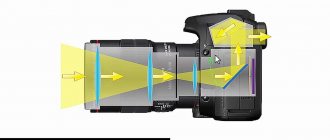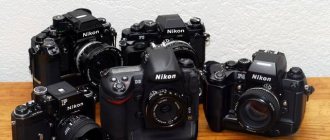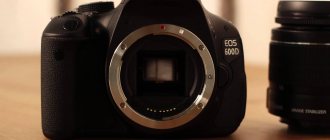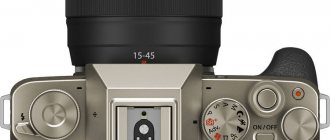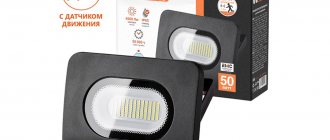Matrix in the camera. What it is?
The matrix in the camera is the main element with which we obtain the image. Also often called a sensor or transducer. It is a microcircuit consisting of photodiodes - photosensitive elements. Depending on the intensity of the incident light, the photodiode generates an electrical signal of different sizes, which is subsequently converted to digital using a separate ADC or built into the matrix.
The matrix captures light and turns it into a set of bits (0/1), which then forms a digital image.
It looks like this:
Matrix in the camera
The shiny rectangular plate in the center is what it is. And along the edges of the photo is the camera mount.
Camera matrix sizes: table
| Format or inches diagonals | Physical size, mm | Device example |
| FF (FullFrame), full frame | 36 × 24 | Dear professional cameras. Canon, Nikon, Sony, Leica |
| APS-C | 23,5 × 15,6 | DSLRs of a wide price range Nikon, Canon, Sony |
| APS-C | 22,3 × 14,9 | DSLRs of a wide price range Canon, Sony, advanced mirrorless cameras |
| 4/3″ or Micro 4/3 | 17,3 × 13,0 | Mirrorless cameras of a wide price range Panasonic, Olympus |
| 1″ | 12,8 × 9,6 | Nikon, Samsung mirrorless cameras and advanced compact cameras |
| 1/2,3″ | 6,16 × 4,62 | The vast majority of soap dishes |
| 1/3″ | 4,69 × 3,52 | Smartphone cameras |
Discrete matrix structure
The basis is very small photodiodes or phototransistors, which capture light and turn it into an electrical signal. One such photodiode forms one pixel of the output digital image.
A little digression for those who may not know. A digital image consists of many dots that our brain “glues” together into a complete picture. If there are not enough such points, we will begin to notice the discreteness of the structure, in other words, it will seem as if the image is “disintegrating”, being mosaic, smooth transitions will disappear.
Let's look at a photo of a dog.
Discrete matrix structure using a dog as an example
Don't mind now that it's in black and white. Abstract from the concept of color, this is a different topic, at the moment it will be better to perceive information. The matrix records an electrical signal of varying magnitude depending on the light intensity. And, if you take away the special filters designed to produce a color image, then the output photo turns out to be black and white. By the way, cameras that shoot exclusively in black and white also exist.
Schematically applied a grid to the image illustrating a discrete one, i.e. discontinuous matrix structure. Each square illustrates the minimum element of the matrix - a pixel formed by a photodiode, which receives light of the Nth intensity and is converted into a digital image pixel of the Nth brightness at the output. For example, the upper left corner is dark, which means that little light fell on this area of the matrix. The wool, on the contrary, is light, which means that more light got there and the electrical signal was different. Naturally, the image consists of a much larger number of squares, here is only a schematic image.
Matrix - analogue of film
Previously, when there were no digital cameras, film was used as a light-sensitive element, that is, a matrix. In principle, the design of a film camera is not too different from a digital one; the latter has more electronics, but the “receiver” of light is completely different.
When you press the shutter button on a film camera, the shutter opens and light hits the film. Before the shutter closes, a chemical reaction occurs, the result of which is an image stored on the film, but invisible to the eye until it is developed. An example of such a chemical process is the decomposition of silver halide into halogen and silver atoms.
As you can see, the essence itself is completely different. I am writing this so that you remember that in the modern world the matrix performs the functions of a film, i.e. forms an image. By the way, the difference between them is in storage: the film is directly the storage location for the final image; in digital photography, the image is stored on memory cards.
Matrix characteristics
It is necessary to be aware that matrices differ greatly from each other, and in different price ranges they have certain qualities. This element can be considered the “heart” of the camera, like the engine in a car or the processor in a computer. Although no machine or computer will work with just an engine or processor, these elements nevertheless determine the potential of the system. It is difficult to expect that a car with a small engine will be able to demonstrate miracles of agility in racing. It’s the same with cameras - in the budget range they are equipped with matrices with limited capabilities, and it’s difficult to expect a silent picture from them when shooting at long exposures. It is clear that there are characteristics that categorize matrices according to capabilities. Let's move on to their consideration.
First, a list of the main characteristics:
- physical size;
- permission;
- signal-to-noise ratio;
- ISO sensitivity;
- dynamic range
- matrix type (obsolete).
Now let's look at everything in detail.
Physical size of the camera matrix
The matrix is a rectangular plate that collects light and is naturally sized. Above, we looked at the discrete structure of the matrix, where we realized that it consists of pixels, which in the physical sense are photocells that convert incoming light into electrical charges.
Accordingly, the physical size of the matrix is determined by the size of the pixels and the distance between them. The greater the distance between the pixels, which is an insulating layer, the less heating the matrix will be, the higher the signal-to-noise ratio and the cleaner the output picture.
Let's move on. The matrix size is one of the most important parameters that you should definitely pay attention to. For novice photographers, I will simply note that the size of the matrix is its most important characteristic
.
In practice, it is marked in millimeters, either as a format designation, or in inches of the sensor diagonal. A format is simply the name of a matrix with certain dimensions. They call it that for simplicity. As for inches, the story goes back to measuring the image area on tubular TVs. It is written, for example, like this: 1/1.8″. You should not make mathematical calculations with the goal of determining the physical size of the diagonal and calculating the dimensions of the sides. It is simply a notation and has no mathematical force. It is only important to understand that a matrix with a diagonal of 1/2.7″ is noticeably smaller than one with a diagonal of 1/1.8″. Here are the popular sizes:
| Format or diagonal inches | Physical size, mm |
| FF (FullFrame), full frame | 36 x 24 |
| APS-C (Nikon) | 23.5 x 15.6 (Nikon) |
| APS-C (Canon) | 22.3 x 14.9 (Canon) |
| 4/3″ or Micro 4/3 | 17.3 x 13.0 |
| 1″ | 12,8 × 9,6 |
| 1/2,3″ | 6,16 × 4,62 |
What does matrix size affect?
The larger the matrix size, the better
This is not always the case, and one can argue with the statement, but in general it is true. More experienced readers are looking forward to the transition of the topic into the holivar channel “Crop vs full frame” :) I won’t indulge their desires now, because we are talking about fundamental things! Let's get back to the topic.
It depends on the matrix size:
- image noise;
- dynamic range;
- color depth;
- camera dimensions.
Indirectly, with a change in the size of the matrix, the depth of field and viewing angle change, because To get a picture at the same scale, you have to change other parameters (focal length, distance to the subject).
The larger the matrix, the:
- Less noisy
image. Physicists will say that the more light that hits the surface that captures it, the less heating, the less error in quantization and, therefore, the less influence of extraneous noise. The image under the same conditions turns out to be more “clean” and detailed. The final image will contain less unnecessary information caused by noise. Now for a more practical definition. With the same number of pixels and the same technology, the larger the matrix, the less noise there will be in the image when shooting in low light. Simply put, there will be fewer extraneous dots in the photo that interfere with viewing. For example, if you intend to shoot handheld twilight portraits, it is preferable to have a camera with a large sensor. The smaller the matrix, the less isolating elements between the pixels. For this reason, increased heating occurs, which is always bad in electronics, the signal-to-noise ratio deteriorates and the amount of noise in the resulting image increases in comparison with models with large matrices. Let's look at an example:
On the left is an image obtained from a camera with a larger matrix, on the right – from a smaller one. The shooting conditions are the same. Enlarge the image. Just look at the sky. The difference may vary, but the trend will continue (provided that the matrices are similar in technology and generation). In practice, noise is clearly visible in the highlights, and by pulling out the shadows by the same amount, you can get a cleaner picture on a camera with a larger sensor. By stretching we mean increasing the exposure in the editor, in this case in the shadows - details begin to appear in them. If you prefer the following genres: evening/night landscapes, portraits during regime time when there is not much light, dynamic reportage photography, pay attention to the noise level of the matrix of the selected camera. In terms of size, it is advisable to choose cameras with matrices starting from APS-C format. - Wider dynamic range (more on this later in the article).
- Greater color depth . Color depth is a measure of how small color changes a camera can detect. Those. with a greater color depth, minor transitions in halftones will look more natural and closer to what is visible to the eye. More halftone information will be recorded. This manifests itself, for example, in almost monochromatic landscapes.
- More camera.
It is an indisputable fact that if you want to shoot with a camera with a larger sensor, you will have to put up with its increased size. Taking a look at the camera market, it becomes clear that, for example, there are no small full-frame cameras, although they are trying to make them. And mobile photography is limited by sensor size. - Greater viewing anglewe can get ceteris paribus. The size of the matrix does not affect the viewing angle!!! The perspective obtained with the same lens mounted on different cameras will be different. But with the same EGF (equivalent focal length), the image will be approximately the same. If the concepts of perspective and EGF don’t mean much to you, that’s okay, just read on, I’ll tell you the important essence “at a glance.” If you take the same lens, then when you shoot on a camera with a larger sensor, you will get a wider view. Let's take the approximation of objects when shooting with a camera with a larger matrix as 100%. Then the same lens on a smaller matrix will provide an approximation of >100% (the approximation will be a multiple of the reduction in the size of the matrix). The same effect can be simulated by cutting out part of the frame from a photograph (shot on a large matrix) and stretching it to its original size. In other words, a boy who was photographed with a 35 mm lens on a camera with an APS-C matrix (look at the matrix size table) will be closer than the same boy photographed with the same lens, but with a full-frame (FF) sensor. The sun on the horizon, shot with a smaller sensor, will be “closer” to us:
- Less depth of field can be obtained, all other things being equal . This is another interesting aspect that confuses photographers and needs to be addressed. Looking ahead, DOF (depth of field) determines at what distance from the focusing point objects will be in the sharpness zone. The size of the matrix does not affect the depth of field!!! But in order for the image scale to be the same on different cameras at the same focal lengths, on cameras with smaller matrices you will have to move further away or change the focal length, which in turn affects the depth of field, increasing it. Therefore, on cameras with large matrices it is easier to get “blurry” photos.
This is not all, but the main points that are critical for the photographer, which are directly or indirectly affected by the size of the camera’s matrix and which you need to clearly understand for yourself.
Matrix type
Defines the principle by which the matrix works. There were two main technologies:
- CMOS (CMOS - complementary logic on transistors);
- CCD (CCD - charge-coupled device).
Matrices based on both technologies accumulate light. Only in the first the smallest structural element is a diode, in the second it is a transistor.
As for image quality, at the time of widespread use of both technologies, it was believed that CCD matrices had a more pleasant, “lamp” color, while CMOS made less noise, but the noise structure was different.
Today, the vast majority of cameras are equipped with CMOS type matrices, which are less noisy and more energy efficient. Therefore, there is no question of choosing according to this parameter. This is just a reminder when using outdated cameras.
Matrix sensitivity. ISO
The ratio of the selected exposure and the output image parameters depends on the sensitivity of the matrix. Simply put, the higher you set the sensitivity (changed in the camera settings), the less lit elements you will be able to register. But at the same time the noise will increase. The ISO parameter is taken as the equivalent sensitivity parameter. It starts from 50 - this is the minimum sensitivity at which the image is as clear as possible and not subject to noise destruction. The change step is formed by multiplying by 2. I.e. the next ISO sensitivity is 100, then 200, 400, 800, 1600, 3200, 6400... Of course, cameras also shoot at intermediate values, for example, 546. But for convenience, steps in feet are considered as described above. Don't worry too much about ISO, stops, etc. right now.
It is important to understand that when shooting the same scene (for example, a tree at dusk), increasing the ISO will increase its brightness.
The picture will appear lighter. It is also important to understand that on a camera with a larger matrix at the same ISO there will be less noise.
Further for those who want to know more. There is such a concept - EI (exposure index). It determines the relationship between the signal transmitted from the matrix and the parameters of its conversion into color space. What does it allow? With the same exposure settings, we are able to obtain images of varying brightness.
Entering the matrix, light forms a signal (output voltage), which is converted into color space in the ADC. The most common is sRGB. At the same time, it is strengthened. If the signal is weak, you need to amplify it more. EI becomes different. Cameras preset a preset range of EI values, called ISO for simplicity. It came from the film world and is now used for convenience. The range depends on the capabilities of the matrix. For example, on older DSLRs it was not possible to set ISO 6400 simply for the reason that at such sensitivity the image quality would become unacceptable due to noise. Next, about strengthening a weak signal.
Signal to noise ratio
The next characteristic of the matrix, inextricably linked with sensitivity, is the signal-to-noise ratio. I think the point is already clear to you. In simple terms, this ratio determines how much useful signal (light from the subject you are shooting) and noise will be contained in the final image.
We said above that when light hits the matrix, its photocells generate signals in the form of an output voltage. Let's say we get a voltage of 0.2 V. Let this, for example, correspond to pure green color according to the sRGB space at ISO 200. By closing the aperture or making the shutter speed shorter, we reduce the light flux entering the matrix. The voltage on the matrix will become not 0.2, but 0.1 V (for example, of course). Which, at a given ISO 200, will correspond not to pure green, but to a darker green with dirty impurities. If we set the camera to ISO 400, the voltage will automatically rise to 0.2 V, and we will get the original pure green color.
BUT! At the same time, a bad component is formed on the matrix in the form of noise, which is not noticeable at base ISO. But by amplifying the signal, we also amplify the noise. Within reasonable limits, this is acceptable and not critical. It is important to understand the line when a subsequent increase in sensitivity and, accordingly, signal-to-noise ratio leads to unacceptable results.
Let's say you take pictures of friends to publish personal photos on social networks. They are not too concerned with the impeccable quality of photographs and want to get great emotions, bright and pleasant pictures. In this case, small or even significant noise, corrected in the editor, will not become a problem. But, if you photograph a landscape and then want to print it out in size 30x40 cm or larger, then it is better to initially set the minimum possible ISO. In principle, when shooting landscapes, stick to the rule of initially setting the minimum ISO. Just set it and forget it, then work with the other parameters.
Signal to noise also depends on pixel size. Therefore, let's move on to the next parameter.
Matrix resolution
A popular parameter that is still used as the main one in some stores.
In the technical documentation you can see, for example, 6000 x 4000. This means that there are 6000 photocells that capture light in width, and 4000 in height. Multiplying, we get the total number of photocells (pixels) on the matrix - 24,000,000. For readability, they write 24 MP . Dimension – megapixels. The prefix “mega” corresponds to the power of 10 to the 6th power.
More megapixels is not better
Modern cameras are usually equipped with matrices from 16 MP and higher. But now it’s not uncommon to have 36 MP and 42 MP. There are also models with higher resolution. This is the traditional marketing ploy that used to “catch” buyers, and even now, by offering to buy high-resolution cameras, “forgetting” about the pitfalls involved and not being interested in the buyer’s goals at all. Let's dig a little deeper and take an interest in the pixel size.
The physical size of a pixel is a very important characteristic, measured in mm or microns. If the pixel is larger, then it will be able to collect more light, and the signal-to-noise ratio will be higher with all the ensuing consequences. Those. such a matrix, other things being equal, will make less noise.
It's very easy to determine. Let's take the popular APS-C format matrix with a resolution of 24 MP, which corresponds to a physical size of approximately 23.6 x 15.8 mm. The resolution in pixels is 6000 x 4000. This means that along the long side, 6000 pixels of our output image are formed at 23.6 mm. We divide the physical distance by the number of points and get a pixel size of approximately 0.004 mm. If a matrix of the same generation, similar structure and physical size has a higher resolution, then the pixel size will be smaller, which will increase heating and noise. They say that heating by about 8 degrees leads to a twofold increase in noise.
Practical Features of Pixel Size:
- Noises.
As has been discussed many times, all other things being equal, smaller pixel = more noise. - Increased movement.
A smaller pixel is more sensitive to hand shake and camera movement relative to the subject. Imagine that a pixel is the size of a tennis ball, and you are filming a cat. A tennis ball-shaped pixel captures the light corresponding to a dark spot on the cat's fur. If you move the matrix with such pixels a little, then light from the same dark spot will most likely fall on this pixel. The offset will not cause global problems in the image. Let's assume that we are filming the same cat with a camera with a matrix with small pixels, and a lint from the cat's spot falls on a certain pixel. By moving the camera a little, it turns out that the pixel will capture another lint. Thus, the detail increases, but the image becomes blurry. This is better suited for certain purposes, but requires greater skills from the photographer and has its own characteristics when shooting certain genres. - Increased requirements for the lens.
The smaller physical pixel size means that to obtain a detailed photograph, the lens resolution must be higher. The lens also has a resolution, and it can project a limited number of points onto each millimeter of the matrix. More expensive lenses have greater resolution. Moreover, if the resolution of the lens is lower than that of the matrix, then the image will not be detailed enough. They say that “the matrix will not open.” In fact, the system is not balanced and the result will be the same as with a cheaper, but balanced technique. The resolution of the camera, as an integral system, does not exceed the resolution of each of the components (matrix or lens). Ideally, their resolution should be approximately equal. But practice, as usual, makes a lot of adjustments. - More resolution means more powerful computer hardware.
The higher the resolution, the greater the demands placed on the computer during processing. If you want to get good results and don’t even shoot in RAW (I advise you to still switch to RAW), then you will still have to “twist” the image in Photoshop or another editor. And at 24MP, 36MP or higher resolutions this can be a problem. Even if small edits are made quickly enough, small delays in a large photoset will be annoying and waste time.
Sensor dynamic range
Dynamic range (abbreviated as DD) determines the maximum brightness range of an image.
Each pixel has its own brightness. To simplify things, we will consider the brightness of individual parts of the frame, for example, the sky. Let's say you're shooting a cityscape on a bright sunny day, and there's a bright sky and very dark buildings in the frame. If you expose the frame to the sky, the result is a well-detailed sky and dark or almost black buildings. On the contrary, by exposing to buildings, we get their normal brightness, but there is absolutely no sky, instead there is a white spot. Have you encountered such a situation? I think for sure.
So the dynamic range just determines how wide the brightness area the camera can cover without losing information in the lightest and darkest parts of the frame.
Dynamic range is a constant characteristic of the matrix, depending on the production technology. We can only narrow it down by setting the ISO sensitivity to a high value, which, as you can imagine, is undesirable.
Insufficient dynamic range of the matrix
In this photo there are quite dark areas at the bottom, and bright sun rays at the top, and the shooting is done in backlight, against the sun. These are obviously difficult conditions for the camera; the contrast is too high.
And here is an even more striking example with a knocked out sky. In fact, a classic, there is plenty of this in many people’s folders, and something needs to be done about it.
Insufficient dynamic range of the matrix
In this case, they say that the scene being filmed does not fit into the dynamic range of the camera. And you need to resort to either recomposing the frame to reduce the contrast of the scene, or using artistic techniques to play up the shortcomings of the technique, or using the technique of its expansion (HDR). You might reasonably ask: “But we see both the blue sky and dark details at the same time. How so?". This fact can be attributed to the imperfection of technology. The dynamic range of the eye exceeds the range of the camera by about 2 times.
A look from the inside: digital camera matrices
Preface
Two months ago, in an article on comparing LCD and E-Ink displays, I mentioned that one of the next reviews would be a “dissection” of the matrix of a modern camera.
And I hasten to fulfill this promise! The first to be included in the “collection” of photosensitive matrices were the front and rear cameras of a smartphone from one well-known Korean manufacturer, which was kindly provided by Vasily Stolyarov. Then the darkwood user, who lives near Moscow, sent me his old, non-working Pentax camera (hereinafter I will deliberately not indicate the exact model of the device). The device was dead and this was a good reason to hand it over into my caring hands, and not throw it away, as many do. And just as I was about to cut, I received another offer from my practically classmate, Ilya. I couldn't refuse this offer. I was presented with a relatively modern Canon that had problems taking images.
Thus, there are three candidates on the red-revolutionary-May Day table: an OEM camera from a phone and cameras from Pentax (the oldest among all participants) and Canon (perhaps the youngest).
If anyone else doesn’t know why we are gathered here, then in the footer of this article there are links to previous “autopsy”. If someone has forgotten how a digital camera works or why a matrix is needed, then you are welcome to Wiki or just watch this video from the Discovery Channel:
The theoretical part. CCD and CMOS
Today, matrices made using CMOS (Complementary Metal-Oxide Semiconductor) technology have conquered more than 90% of the world market, and not so long ago, the insanely popular CCD (Charge-Coupled Device) is already predicting a quick decline.
There are many reasons for this, here is not a complete list of the advantages of CMOS technology: firstly, low power consumption in a static state compared to CCD, secondly, CMOS immediately “produces” a digital signal that does not require additional conversion (more precisely, the conversion occurs on each individual subpixel), unlike CCD, which is actually an analog device; thirdly, low cost of production, especially with large matrix sizes.
You can briefly get acquainted with the principles of operation of CMOS matrices using two videos from Canon:
But all of our patients (maybe with the exception of the mobile phone camera matrix) belong to the era when CCD reigned supreme in the world, and CMOS was just gaining strength and light sensitivity to subsequently take a leading position. Therefore, I will still say a few words about how the CCD matrix works. A more detailed description can always be found on the Wiki pages.
So, a photon from the subject, passing through a Bayer filter, that is, an RGBG color filter, or an RGBW filter and a collecting microlens, hits the photosensitive semiconductor material. Being absorbed, the photon generates an electric-hole pair, which is “separated” in the cell under the influence of an external electric field, and the electron is “sent” to the piggy bank - a potential well, where it will wait for “reading”.
Diagram of the CCD matrix device (Source)
Reading the CCD matrix occurs “cell by cell”, so to speak. Let's say we have a 5 by 5 pixel array. First, we read the number of electrons, or simply the amount of electric current, from the first pixel. Then a special controller “shifts” all the cells by one, that is, the charge from the second cell flows into the first. The value is read again and so on until all 5 cells have been read. Next, another controller shifts the remaining “image” down one line and the process is repeated until the currents are measured in all 25 cells. This may seem like a long process, but for 5 million pixels it takes just a fraction of a second.
The process of reading an image from a CCD matrix (Source)
To make it completely clear, I suggest you watch the following videos:
Practical part
Usually, beautiful disassemblies are carried out by people in snow-white gloves, recently they got to cameras, but they say that for video assembly instructions you need to pay extra by sending an SMS to a short number.
Further, slightly more than completely clumsy methods will be used, so I do not recommend repeating this at home... How to disassemble a cell phone can always be seen on the pages of the previous article, so I will not present these heartbreaking shots here again.
The above-mentioned Pentax camera was provided by Monsieur DarkWood, whose heart, it seems to me, should now be bleeding, and a stingy male tear rolling down his cheek:
Pentax disassembly in photographs
Of all the variety of details, we are currently only interested in the LCD display, which will be shown to schoolchildren who come to us, on FNM, on excursions, the CCD matrix itself, glass with something suspiciously reminiscent of a polarizer or filter, and IR illumination (red light) for night shooting. It is worth noting that the matrix is rigidly fixed to the camera body. Consequently, all the vibrations of your hands will be easily transmitted directly to the matrix itself, which, you see, does not in any way contribute to high-quality photography. Apparently, DarkWood has reinforced concrete nerves.
However, that didn’t stop him from “drowning” his favorite camera. Remember, when you go to warm countries at sea in the summer and try to photograph the next rolling wave, that a camera is a device in which currents can lead to corrosion.
Traces of corrosion right on the cable leading to the shutter button (unfortunately, not the only place like this)
It is immediately clear that Canon is a slightly more advanced, more modern model than Pentax. For example, the matrix is spring-loaded (small springs are clearly visible in the lower left image). Such a passive image stabilization system helps to obtain higher quality and clearer pictures, unless, of course, you are a neurasthenic in an advanced stage!
"Insides" Canon
By the way, in the photo at the bottom right you can clearly see a huge capacitor responsible for the flash, because of problems with which I once had to write off my Canon digital point-and-shoot camera.
Mobile phone camera
Let's start our research with a mobile phone camera, which will not be devoted much time and words in this article due to the fact that the matrix itself has completely microscopic dimensions and is difficult to work with (sawing, grinding).
As it is not difficult to notice, in the optical micrographs below the matrix at the edge has two zones: a lighter and a darker one. I hope that everyone has already guessed: there are no diodes under the bright side, it is applied just like that, with a margin in order to maximally cover the subtle spiritual organization of the matrix...
We'll cover everything with reserve - we don't mind
Microphotographs obtained using an optical microscope differ significantly from those produced by an electron microscope. For example, what about “sphere quadrature”?
The fact is that in optics we do not see any transparent layers (even if they are simply less noticeable), while electron microscopy is primarily a method of surface analysis, that is, it may well be that round color filters are covered on top square "caps". Moreover, the dimensions of such a cubic spherical subpixel are about 2.5 micrometers.
This is how it is, the squaring of the sphere...by the way, in a vacuum...
Pentax camera matrix
Let's start our study of the CCD matrix of a Pentax camera with optical microphotographs. To my deep regret, due to steric hindrances, as chemists say, in the sample-microscope system, it was not possible to take pictures at high magnifications and examine individual subpixels.
Something is written, I wonder, is it possible to see the names of little Chinese children here somewhere?
Each landing pad for contacts is numbered, but not each one has the same contact wire.
And this is how we will soon learn to count – with the help of nanotechnology, of course...
A clear boundary between the matrix itself and the “piping”
And the following micrograph is worthy of a textbook on electron microscopy. Do you know why an electron microscope is not a measuring tool? Yes, yes, that’s why: due to the local accumulation of charge, seemingly spherical objects suddenly became ellipsoids:
But we know that these are spheres...
Next, let's take a look at what is around the photosensitive matrix. Since I am not an expert in the field of creating electronic circuits, I’m afraid to even imagine why all these complex designs and “intricacies” of conductors are needed, maybe there is someone ready to explain the purpose of the parts and components below (in the comments, of course same)?
Unshakable columns that have survived sawing and polishing...
You can get entangled in these layers and break a leg or two.
This issue “A Look from the Inside” is a landmark issue; after several years of “ordeals,” we have finally installed a new microanalysis system, so in some cases, I can not only provide beautiful pictures, but also explain what chemical elements what we see consists of.
And here is the most interesting thing - the matrix in all its glory. Under the mesh, in the cells of which microspheres-lenses are located, you can see individual photosensitive elements (or their remains, to be more precise, it’s difficult to say). Below, when discussing the Canon matrix, I will explain in detail the “cross-section” design of the matrix. For now, let us turn to the data of local chemical analysis. It turns out that the mesh consists of tungsten, and the microspheres, apparently, are silicon dioxide, which is “covered” on top with some kind of polymer material. A more detailed analysis can be found here.
The Matrix in all its intricate beauty
Returning to the first SEM image in this chapter, the contact pads are made of pure gold (oh yeah!), but the conductors inside the sensor appear to consist of aluminum, on which a thin layer of copper is sputtered, the content of which is on the verge of sensitivity of the device. Detailed information is presented here.
Canon camera matrix
We will continue our immersion into the micro- and nanoworlds, as usual, with optical microscopy. As in the case of Pentax, the matrix from the Canon camera could not be photographed at high magnification due to geometric inconsistencies. However, from the obtained microphotographs, it is possible to estimate the size of an individual subpixel - about 1.5 microns, which is much smaller than that of a mobile phone matrix.
Optical micrographs of a Canon sensor
By the way, one of the culprits for the inability to take pictures on an optical microscope at high magnifications is the “cover” glass, which covers the matrix and its “filling”:
Good shot: transmission behind glass
Of course, the most interesting things are always hidden on the chips, where the falling apart strictly ordered world gives a crack, allowing you to look into the most sacramental corners of the device:
We'll come back to the yellowish-orange areas of this photo a little later...
Already familiar to us columns of completely unclear purpose:
Like steadfast tin soldiers
Now let's take a closer look at the structure of the CCD matrix. On top, the CCD matrix is covered with something resembling a polymer layer (1), which protects the photosensitive elements from the aggressive external environment. Below it are microlenses with dye (2 and 3). But since electron microscopy does not allow obtaining color images, it is not possible to say for sure whether a large or small sphere is colored. Microlenses made of silicon dioxide (the most likely material for their manufacture) are fixed in the cells of a tungsten mesh (4), under which photosensitive elements (5) are hidden. And, of course, this entire structure rests on a substrate made of the purest silicon!
Taking into account the fact that the matrix is additionally protected by a “covering” glass, the photocells are protected better than the President of the Russian Federation in his limousine (if, of course, we correct for the scale factor).
Microanalysis data can be downloaded here.
Arrangement of the matrix point by point. Description in the text
But that's not all. We still have a piece of glass remaining covering the matrix, which, it seems, is a polarizer. It is somewhat rough around the edges, but almost perfectly smooth throughout the rest of the surface area. It seems that optical microscopy does not give any results: glass is like glass.
Glass with a suspected polarizer: nothing unusual
And only with the help of electron microscopy is it possible to see the chemical contrast in the image and the striped structure. The thickness of such a “film” is only 2.5 micrometers, while the sizes of individual layers are 180 and 100 nm, respectively, for darker and lighter ones. Based on microanalysis data (here), I would venture to suggest that the darker areas are enriched in titanium, and the light areas are enriched in aluminum. I think this is amazing!
It turns out that the camera has its own striped life inside!
Afterword
Such a world of the passing century of CCD matrices appears before us today.
Thanks to everyone (Vasily for the phone, Ilya and DarkWood for the cameras) who made their contribution to the creation of this article. Well done to you for supporting us in this difficult endeavor!
And the apotheosis of this article, or rather its apotheosis:
Rest in peace until we come up with a new use for you.
Bonus 1. What does a green dust storm look like in Moscow?
At first I wanted to post it as a separate post, but decided not to clutter up the space.
Just a few days ago, Moscow was covered by a yellow-green cloud, many had already begun to prepare for the coming of the apocalypse, but nothing happened... What in reality was the reason for such a strange color? The climate on this planet has been acting up lately: either it will be left without snow for the New Year, or it will be covered to the very top with snow, then spring will be like winter, then suddenly summer will come. Flowers, trees and vegetation are less adapted to this kind of disturbance, so 1.5 months of spring compressed into 1 week forced plants to reconsider their plans for reproduction...
In the morning, sitting down at my desk, I discovered a layer of dust on it, and after wiping it with a napkin, I realized that I needed to study this dust properly. No sooner said than done!
But I have two news for everyone: good and bad.
The good news is that the color of the yellow-green cloud was indeed due to a large amount of pollen (I counted at least three types):
Composition of the Moscow storm: pollen... Below right, pollen on the surface of a part of the plant
The bad news is that we also breathe this, and every day, and not during plant reproduction periods (micro- and nanoparticles that not every filter will catch):
Composition of the Moscow storm: not very pleasant dust and dirt
Bonus 2. Guess what it is?
PS
Recently, a large number of posts on the topic of copyright and “pay what you want” began to appear on HabraHabr. For example, they collect donations for ReactOS or for publishing/writing books. I thought about it and decided to “get involved” in this too, so it’s up to you, dear readers:
Yandex.Money 41001234893231 WebMoney (R296920395341 or Z333281944680)
In a week we managed to collect about 2,500 rubles - THANK YOU to everyone who responded and made their contribution!!!;)
P.P.S.
By the way, I unexpectedly discovered that some of my works for sawing certain objects encourage people to make their own discoveries.
Firstly
, a complete list of published articles on Habré:
Opening of the Nvidia 8600M GT chip, a more detailed article is given here: Modern chips - a look from the inside A look from the inside: CD and HDD A look from the inside: LED light bulbs A look from the inside: LED industry in Russia A look from the inside: Flash memory and RAM A look from the inside: the world around us A look From the inside: LCD and E-Ink displays From the inside: digital camera matrices From the inside: Plastic Logic From the inside: RFID and other tags From the inside: PhD studies at EPFL. Part 1 A look from the inside: postgraduate studies at EPFL. Part 2 A look from the inside: the world around us - 2 A look from the inside: the world around us - 3 A look from the inside: the world around us - 4 A look from the inside: 13 LED lamps and a bottle of rum. Part 1 A look from the inside: 13 LED lamps and a bottle of rum. Part 2 A look from the inside: 13 LED lamps and a bottle of rum. Part 3 A look from the inside: IKEA LED strikes back A look from the inside: are Filament lamps really that good?
and 3DNews: Microview: comparison of displays of modern smartphones
Secondly
, in addition to the blog on HabraHabr, articles and videos can be read and watched on Nanometer.ru, YouTube, and also Dirty.
Third
, if you, dear reader, liked the article or want to stimulate the writing of new ones, then act according to the following maxim:
“pay what you want”
Yandex.Money 41001234893231 WebMoney (R296920395341 or Z333281944680)
Sometimes briefly, and sometimes not very much about science and technology news You can read it on my Telegram channel - you are welcome;)
